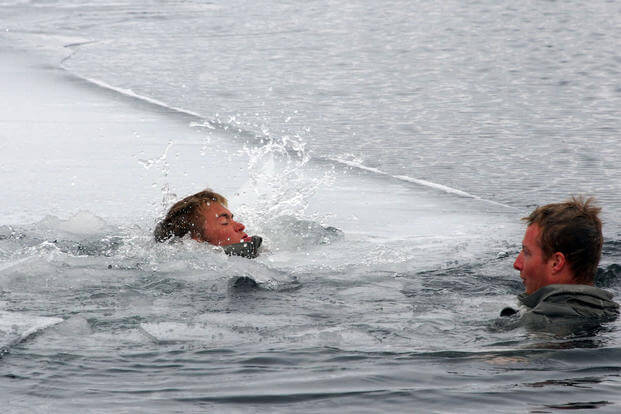There is an argument as to whether some people are wired genetically to handle colder temperatures, or whether one must build stamina for lower temperatures by training in colder environments (water or land). I believe it is a little bit of both.
When I was attending SEAL training, the water off San Diego was brutal to new recruits. Typically, water temperatures were (at best) 69 degrees during the warmest part of the summer and dropped into the low 50s during the winter. Then during the dive phase, at about 15 feet underwater, you would hit a thermo-cline and water temperature was in the low 40s. That was when BUD/S got cold, especially during a winter dive phase.
Even if the water is 90 degrees, your core temperature very slowly will start to drop from its normal level of 98.6 degrees. This would take hours at that temperature, but as the water temperature drops, so does the amount of time you can train safely in that water.
People often ask me, "What is the best way to train for the cold water at BUD/S? Do I take ice baths, cold showers or sit in a pool for hours?" What I think helped me was hours of surfing/body surfing a few years prior to BUD/S. Physical training such as swimming, surfing and playing in water temperatures near those of San Diego is what I would recommend for short periods of time.
Do not let yourself get to a point where you are shaking uncontrollably or (especially) not shaking at all, as you can die if you play around too much with your core temperature. I therefore do not recommend placing ice in a bathtub and dropping the water temperature to arctic levels. Colder showers are OK if you like mild torture, but training for cold-water endurance by yourself can be dangerous.
As part of National Geographic Channel's Fight Science series, which will be shown in January 2008, I ran a combat obstacle course after my body temperature had dropped to near hypothermic levels after immersion in 45-degree water. Needless to say, it was -- for this 38-year-old fitness writer -- painful.
But I did abnormally well and surprised myself. In fact, the physiologists monitoring my temperature and other vitals actually called me a "freak." However, this test was done with doctors, EMTs, physiologists and thermal imagery professionals and is not meant to be duplicated by viewers on their own. The physiologists even scientifically rewarmed me, using a new device that gently rewarms the core through the hands and feet. The ensuing combat obstacle course went well, too, reinforcing the theme of the show: Special Ops are special, with intangible skills that are difficult to verbalize.
So along with underwater swimming, swimming by yourself and other potentially dangerous SEAL training events, getting used to cold water is not recommended for pre-SEAL candidates. Train smart or you can kill yourself when not properly trained or have trained supervisors protecting you. Besides, you will have a harder time keeping up with the runs, swims, obstacle courses and PT on a daily basis than being cold. So focus on preparing hard physically, then rehab yourself by using ice on your joints.
Navy Special Operations fitness articles:
- Navy SEAL Fitness Test
- Navy SEAL Fitness Preparation
- Getting Fit for SEAL Training
- The Complete Guide to Navy SEAL Fitness
- How to Prepare for BUD/S
- Navy SWCC Fitness Training
- All Navy Special Operations Fitness
Stew Smith is a former Navy SEAL and fitness author certified as a Strength and Conditioning Specialist (CSCS) with the National Strength and Conditioning Association. Visit his Fitness eBook store if you're looking to start a workout program to create a healthy lifestyle. Send your fitness questions to stew@stewsmith.com.
Want to Learn More About Military Life?
Whether you're thinking of joining the military, looking for fitness and basic training tips, or keeping up with military life and benefits, Military.com has you covered. Subscribe to Military.com to have military news, updates and resources delivered directly to your inbox.



















